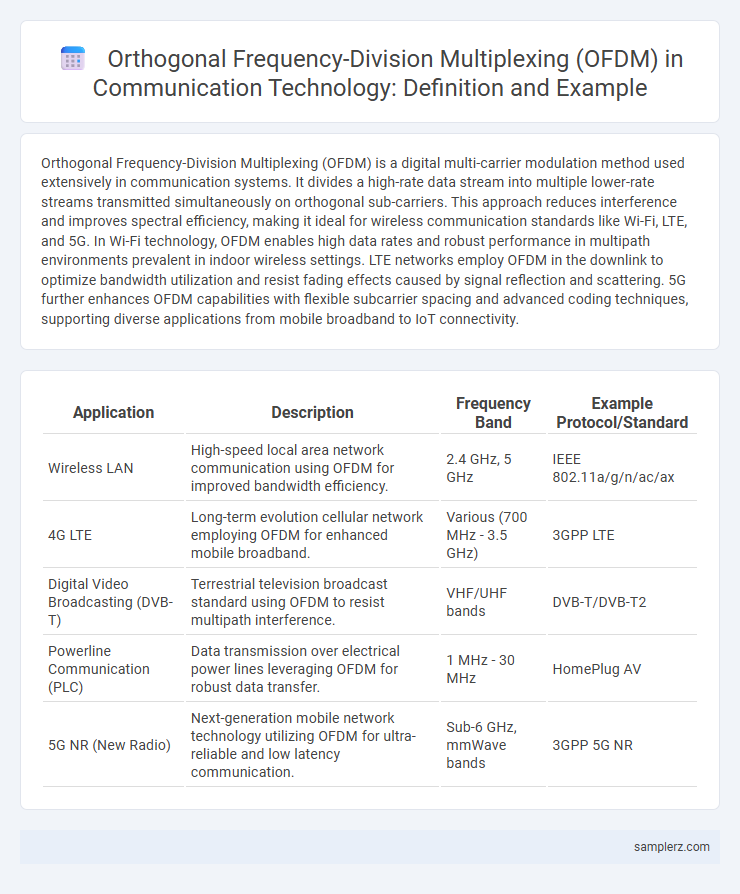Orthogonal Frequency-Division Multiplexing (OFDM) is a digital multi-carrier modulation method used extensively in communication systems. It divides a high-rate data stream into multiple lower-rate streams transmitted simultaneously on orthogonal sub-carriers. This approach reduces interference and improves spectral efficiency, making it ideal for wireless communication standards like Wi-Fi, LTE, and 5G. In Wi-Fi technology, OFDM enables high data rates and robust performance in multipath environments prevalent in indoor wireless settings. LTE networks employ OFDM in the downlink to optimize bandwidth utilization and resist fading effects caused by signal reflection and scattering. 5G further enhances OFDM capabilities with flexible subcarrier spacing and advanced coding techniques, supporting diverse applications from mobile broadband to IoT connectivity.
Table of Comparison
| Application | Description | Frequency Band | Example Protocol/Standard |
|---|---|---|---|
| Wireless LAN | High-speed local area network communication using OFDM for improved bandwidth efficiency. | 2.4 GHz, 5 GHz | IEEE 802.11a/g/n/ac/ax |
| 4G LTE | Long-term evolution cellular network employing OFDM for enhanced mobile broadband. | Various (700 MHz - 3.5 GHz) | 3GPP LTE |
| Digital Video Broadcasting (DVB-T) | Terrestrial television broadcast standard using OFDM to resist multipath interference. | VHF/UHF bands | DVB-T/DVB-T2 |
| Powerline Communication (PLC) | Data transmission over electrical power lines leveraging OFDM for robust data transfer. | 1 MHz - 30 MHz | HomePlug AV |
| 5G NR (New Radio) | Next-generation mobile network technology utilizing OFDM for ultra-reliable and low latency communication. | Sub-6 GHz, mmWave bands | 3GPP 5G NR |
Introduction to Orthogonal Frequency-Division Multiplexing (OFDM)
Orthogonal Frequency-Division Multiplexing (OFDM) is a digital multi-carrier modulation technique widely used in modern wireless communication systems such as 4G LTE and Wi-Fi. By dividing a high data rate stream into multiple lower rate streams transmitted simultaneously over orthogonal subcarriers, OFDM efficiently mitigates multipath fading and inter-symbol interference. This spectral efficiency and robustness against channel impairments make OFDM a fundamental technology in broadband communication standards.
Key Principles of OFDM in Modern Communication Systems
Orthogonal Frequency-Division Multiplexing (OFDM) utilizes closely spaced orthogonal subcarriers to efficiently transmit data over multipath fading channels, minimizing interference and enhancing spectral efficiency. Key principles include dividing the data stream into multiple parallel substreams, each modulated onto different frequencies, and employing a cyclic prefix to combat inter-symbol interference. This approach enables reliable high-speed wireless communication in systems like LTE, Wi-Fi, and 5G, supporting high data rates and robust performance in complex signal environments.
Wireless Broadband: OFDM in Wi-Fi Technologies
Orthogonal Frequency-Division Multiplexing (OFDM) is a core technology in Wi-Fi standards such as IEEE 802.11a/g/n/ac/ax, enabling high-speed wireless broadband communication through efficient spectrum utilization and resistance to multipath interference. By dividing a signal into multiple orthogonal sub-carriers, OFDM enhances data transmission rates and improves reliability in environments with complex signal reflections. This modulation technique supports scalable bandwidths and advanced features like MIMO (Multiple Input Multiple Output), critical for delivering robust Wi-Fi connectivity in dense urban and indoor scenarios.
OFDM Application in 4G and 5G Mobile Networks
Orthogonal Frequency-Division Multiplexing (OFDM) serves as a core modulation technique in both 4G LTE and 5G NR networks, enabling high data rate transmission with improved spectral efficiency and resistance to multipath fading. In 4G LTE, OFDM facilitates the use of multiple subcarriers for robust broadband wireless communication, supporting speeds up to 1 Gbps in ideal conditions. The evolution to 5G leverages OFDM's flexible subcarrier spacing to optimize performance across diverse frequency bands, including mmWave, enhancing latency, capacity, and connectivity for massive IoT deployments and ultra-reliable low-latency communications (URLLC).
Digital Television Broadcasting Using OFDM
Digital television broadcasting uses Orthogonal Frequency-Division Multiplexing (OFDM) to enhance signal robustness and spectral efficiency, especially in environments with multipath interference. OFDM divides the digital signal into multiple closely spaced orthogonal subcarriers, allowing simultaneous transmission and minimizing inter-symbol interference. This technology underpins standards such as DVB-T (Digital Video Broadcasting - Terrestrial), enabling high-quality, reliable television reception over the air.
Powerline Communication and OFDM Integration
Powerline Communication (PLC) utilizes Orthogonal Frequency-Division Multiplexing (OFDM) to enhance data transmission over electrical wiring by dividing the signal into multiple orthogonal subcarriers, reducing interference and multipath distortion. The integration of OFDM in PLC systems significantly improves communication reliability and bandwidth efficiency in smart grid and home networking applications. Advanced OFDM techniques enable PLC to overcome channel noise and signal attenuation challenges inherent to powerline environments.
OFDM in Radio Broadcasting: The Case of DAB and DRM
Orthogonal Frequency-Division Multiplexing (OFDM) plays a crucial role in modern radio broadcasting standards such as Digital Audio Broadcasting (DAB) and Digital Radio Mondiale (DRM). In DAB, OFDM enables robust multi-path resistance and enhances spectral efficiency, supporting high-quality audio transmission over terrestrial networks. DRM leverages OFDM to provide reliable digital radio services with improved coverage and interference immunity in the AM broadcast bands.
Optical Fiber Communications Employing OFDM
Optical Fiber Communications employing Orthogonal Frequency-Division Multiplexing (OFDM) significantly enhance data transmission rates by dividing the optical signal into multiple orthogonal subcarriers, reducing inter-symbol interference and dispersion effects. This technique optimizes spectral efficiency and supports high-capacity long-distance communication networks in modern fiber-optic infrastructure. Advanced modulation formats combined with OFDM enable robust performance under nonlinear fiber impairments and polarization mode dispersion.
Satellite Communication Systems Leveraging OFDM
Satellite communication systems utilize Orthogonal Frequency-Division Multiplexing (OFDM) to enhance data transmission efficiency and spectral utilization. OFDM mitigates multipath fading and co-channel interference in satellite links, enabling higher data rates and robust signal integrity. This technology supports broadband services and reliable connectivity in remote regions through improved bandwidth management and error resilience.
Future Prospects and Innovations in OFDM-Based Communication
Future prospects of orthogonal frequency-division multiplexing (OFDM) in communication include integration with 5G and 6G networks, enhancing spectral efficiency and reducing latency. Innovations such as adaptive OFDM and machine learning-driven resource allocation improve robustness in dynamic channels and optimize system performance. Emerging applications in IoT and massive MIMO systems leverage OFDM's scalability to support massive connectivity and ultra-reliable low-latency communication (URLLC).

example of orthogonal frequency-division multiplexing in communication Infographic
 samplerz.com
samplerz.com